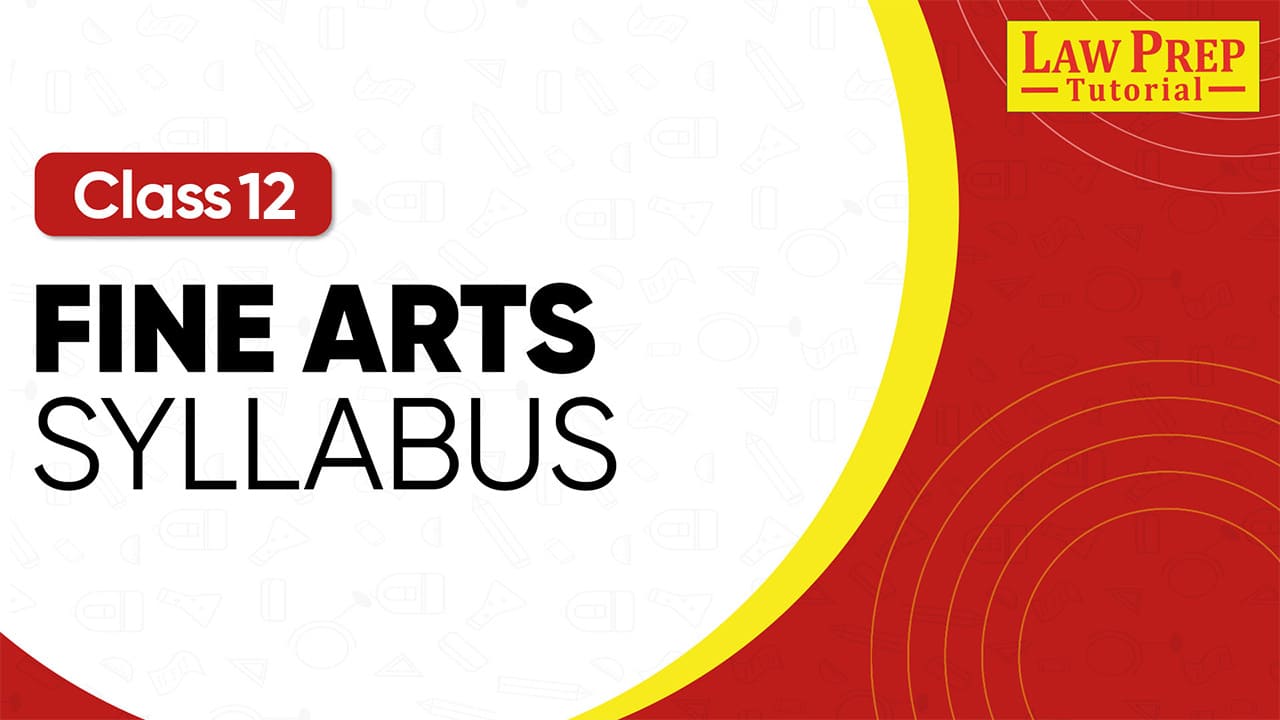The CBSE Class 12th Fine Arts syllabus 2025-26 is designed to enhance creativity, imagination, and appreciation of Indian art. It builds on the foundation laid in Class 11 and prepares students for higher studies in visual arts, design, and related fields.
Students can choose from four courses – Painting (049), Graphics (050), Sculpture (051), or Applied Art – Commercial Art (052).
The syllabus balances theory and practical learning, with emphasis on History of Indian Art and portfolio-based practice. Below, we have covered the complete Class 12 Fine Arts syllabus, exam pattern, objectives, preparation tips, projects, and a free PDF download.
Class 12 Fine Arts Syllabus 2025-26: Overview
CBSE offers Fine Arts at the senior secondary level with four optional courses. Students must choose any one of the following:
- Painting (Code 049)
- Graphics (Code 050)
- Sculpture (Code 051)
- Applied Art – Commercial Art (Code 052)
| Part | Details | Marks |
| Theory | History of Indian Art (common for all four courses) | 30 |
| Practical | Varies as per chosen course (Painting/Graphics/Sculpture/Applied Art) | 70 |
| Total | 100 Marks | |
| Exam Duration | Theory – 2 Hours Practical – 6 Hours (3+3 with 1-hour break) | – |
📥 Download Class 12 Fine Arts Syllabus PDF
For easy reference, here is the official CBSE Class 12 Fine Arts Syllabus PDF 2025-26.
Class 12th Fine Arts Syllabus 2025-26 (Theory)
Whether you choose painting, graphics, sculpture or applied art, the class XII fine arts syllabus of theory part is same for all:
Time: 2 Hours
| Unit | Topics Covered | Marks |
| Unit 1 | The Rajasthani School of Miniature Painting • Origins and development • Main features • Selected paintings: Maru-Ragini, Raja Aniruddha Singh Hara, Chaugan Players, Krishna on Swing, Radha (Bani-Thani), Bharat Meets Rama at Chitrakuta | 10 |
| Unit 2 | The Pahari School of Miniature Painting • Origins and development • Main features • Selected paintings: Krishna with Gopis, Nand, Yashoda and Krishna with Kinsmen going to Vrindavana, Cosmic Dance of Shiva (Nandikeshvara), Krishna with Gopis | 10 |
| Unit 3 | The Mughal and Deccan Schools of Miniature Painting • Origins and development • Main features • Selected paintings: Jahangir holding the picture of Abdur Rahim Khan-i-Khana, Falcon on a Bird-Rest, Kabir and Raidas, Marriage procession of Dara Shikoh • Deccan School: Hazrat Nizamuddin Auliya and Amir Khusro, Chand Bibi Playing Polo | 10 |
| Total | 30 |
More Important Resources for CBSE Exam:
| CBSE Board: All details | CBSE Class 11 Commerce Subjects |
| CBSE Full Form | All about CBSE Class 11th |
| Class 11th Hornbill Syllabus |
Class 12th Fine Arts Syllabus 2025-26 (Practical)
The practical syllabus of fine arts in class 12th is different for all categories:
1. Painting Practical – 70 Marks
Time: 6 Hours (3+3 with 1-hour break)
| Unit | Content | Marks |
| 1. Nature and Object Study (Observation Based) | • Study of objects, plants, and geometric forms with pencil/colours showing light and shade. | 25 |
| 2. Painting Composition (Imagination Based) | • Drawing & colouring based on daily life, human figures, festivals, and surroundings. | 25 |
| 3. Portfolio Assessment | • Record of year’s performance (sketch to finished work). • Five selected works (studies + compositions).- At least one work inspired by Indian Folk Art. | 20 |
| Total | 70 |
2. Graphics Practical – 70 Marks
Time: 6 Hours (3+3 with 1-hour break)
| Part | Content | Marks |
| 1. Relief Printing (Linocut/Woodcut/Paper-cardboard) | • Basics of printmaking methods and use of tools. • Understanding inks, solvents & registration methods. • Execution of a creative composition in relief printing. | 50 |
| 2. Portfolio Assessment | • Record of year’s work (sketch to final print). • At least three selected prints from the year’s work. • Two prints based on Indian Folk Art. | 20 |
| Total | 70 |
3. Sculpture Practical – 70 Marks
Time: 6 Hours (3+3 with 1-hour break)
| Part | Content | Marks |
| 1. Modelling in Relief (Clay/Plaster of Paris) | • Relief work inspired by nature, folk art, or daily life. • Use of geometric and natural forms in composition. | 25 |
| 2. Modelling in Round (Clay/Plaster of Paris) | • Three-dimensional sculptures of simplified human figures, animals, or objects. • Techniques like coiling, slab, or direct carving. | 25 |
| 3. Portfolio Assessment | • Record of year’s performance (sketch → final sculpture). • Four selected works (Relief + Round). • At least one work inspired by Indian Folk Art. | 20 |
| Total | 70 |
4. Applied Art Practical – 70 Marks
Time: 6 Hours (3+3 with 1-hour break)
| Part | Content | Marks |
| 1. Drawing | • Still life and nature study. • Medium: pencil, monochrome, watercolour, or ink. | 25 |
| 2. Lettering & Layout | • Study of Roman and Devanagari scripts. • Designing simple layouts such as posters, book covers, or advertisements. | 25 |
| 3. Portfolio Assessment | • Record of year’s performance (sketch to final artwork). • Four selected drawings. • Two works in chosen applied art. • At least one work inspired by Indian Folk Art. | 20 |
| Total | 70 |
Class XII Fine Arts Syllabus: Exam Pattern & Evaluation Scheme
1. Theory Exam
- Maximum Marks: 30
- Duration: 2 Hours
- Content: History of Indian Art (common for all four courses).
- Units Covered:
- The Rajasthani School of Miniature Painting
- The Pahari School of Miniature Painting
- The Mughal and Deccan Schools of Miniature Painting
2. Practical Exam
- Maximum Marks: 70
- Duration: 6 Hours (3+3 with 1-hour break).
- Components by Course:
- Painting: Nature & Object Study (25), Composition (25), Portfolio (20)
- Graphics: Relief Printing (50), Portfolio (20)
- Sculpture: Modelling in Relief (25), Modelling in Round (25), Portfolio (20)
- Applied Art: Drawing (25), Lettering & Layout (25), Portfolio (20)
3. Portfolio Assessment (20 Marks – Common for All Courses)
- Record of the year’s performance (sketches → final works).
- Selected studies and compositions.
- At least one work based on Indian Folk Art.
- Criteria for marking:
- Creativity & Originality: 6 marks
- Technical Skill: 6 marks
- Presentation & Aesthetic Quality: 4 marks
- Folk Art / Personal Style: 4 marks
Check the latest CBSE Class 11 syllabus for all subjects below:
| Class 11th History Syllabus | Class 11th Chemistry Syllabus |
| Class 11th Legal Studies Syllabus | Class 11th Biology Syllabus |
| Class 11th Accountancy Syllabus | Class 11th Psychology Syllabus |
| Class 11th Entrepreneurship Syllabus | Class 11th Fine Arts Syllabus |
| Class 11th Business Studies Syllabus | Class 11th Sociology Syllabus |
| Class 11th Maths Syllabus | Class 11th Economics Syllabus |
| Class 11th Political Science Syllabus | Class 11th English Syllabus |
| Class 11th Physics Syllabus | Class 11th Hindi Syllabus |
| Class 11th Geography Syllabus | Class 11th Computer Science Syllabus |
| Class 11th Informatics Practices Syllabus | Class 11th Physical Education Syllabus |
| Class 11th Home Science Syllabus | Class 11th Sanskrit Syllabus |
Prescribed Books for CBSE Class 12 Fine Arts Syllabus 2025-26
| Course | Prescribed Books |
| Painting (049) | • An Introduction to Indian Art: Part II (NCERT) • Creative Art Manual: Painting (as per CBSE guidelines) |
| Graphics (050) | • An Introduction to Indian Art: Part II (NCERT) • Creative Art Manual: Graphics |
| Sculpture (051) | • An Introduction to Indian Art: Part II (NCERT) • Creative Art Manual: Sculpture |
| Applied Art – Commercial Art (052) | • An Introduction to Indian Art: Part II (NCERT) • Creative Art Manual: Applied Art |
Objectives of Class 12 Fine Arts Syllabus 2025-26
The Fine Arts syllabus for Class 12 is designed to refine artistic skills, promote creativity, and deepen understanding of India’s cultural heritage. The main objectives are:
- Enhance Creativity and Expression: Encourage students to explore ideas, experiment with forms, and express themselves artistically.
- Strengthen Observation and Imagination: Train learners to notice details in nature, objects, and life situations, and translate them into art.
- Cultural Awareness: Develop respect for India’s rich traditions of painting, sculpture, architecture, and folk art.
- Technical Skill Development: Provide hands-on training in Painting, Graphics, Sculpture, or Applied Art to build confidence and proficiency.
- Aesthetic Sensibility: Cultivate the ability to appreciate beauty, balance, and harmony in artworks.
- Critical & Analytical Thinking: Enable students to study artworks historically, socially, and culturally.
- Portfolio Building: Prepare a creative collection of works that reflects individual style and originality.
Tips to Prepare for Class 12 Fine Arts Syllabus 2025-26
1. Read NCERT Theory Carefully
Focus on An Introduction to Indian Art – Part II. Learn features, schools of miniature painting, and key artworks with dates and artists.
2. Practice Daily for Practicals
Dedicate at least 1–2 hours daily for sketching, painting, or sculpting. Consistency is key to improving technique and creativity.
3. Keep a Well-Maintained Portfolio
Organize works chronologically – sketches, studies, final pieces. Include at least one artwork inspired by Indian Folk Art.
4. Use Real-Life Inspirations
Observe nature, objects, people, and festivals to create authentic compositions. This makes your work unique and relatable.
5. Experiment with Mediums
Try pencil, watercolour, ink, acrylics, clay, or printmaking tools depending on your chosen course. It adds versatility to your portfolio.
6. Prepare Notes for Theory Revision
Make short notes with bullet points, flowcharts, or diagrams for each art school. These are handy during last-minute study.
7. Visit Art Exhibitions & Museums
Exposure to original artworks and sculptures enhances understanding and appreciation of techniques and history.
8. Revise Regularly
Revise both practical techniques and theory topics weekly to avoid last-minute stress.
Suggested Project Work & Portfolio Preparation for Class 12 Fine Arts
Portfolio and project work are an essential part of Fine Arts practical evaluation. They highlight a student’s creativity, consistency, and understanding of art.
Components of Portfolio
- Record of Progress: From initial sketches to completed artworks.
- Nature & Object Studies: Still life drawings, observation-based works.
- Compositions: Imagination-based paintings, sculptures, or prints.
- Folk Art Integration: At least one work inspired by Indian Folk Art (Warli, Madhubani, Pattachitra, Gond, etc.).
- Original Work: An artwork showing the student’s personal style.
Suggested Project Work Ideas
- Create a series of paintings or prints based on Indian festivals or daily life.
- Document local folk art traditions and present them visually.
- Develop a sculpture inspired by Indian mythology.
- Make advertising posters/book cover layouts (for Applied Art).
- Prepare a visual diary/sketchbook with observations of nature, objects, and people.
- Create artworks that blend modern themes with traditional styles.
Evaluation Criteria (20 Marks)
- Creativity & Originality: 6 marks
- Technical Skill & Use of Medium: 6 marks
- Presentation & Aesthetic Quality: 4 marks
- Folk Art/Personal Style Integration: 4 marks
Read the chapter-wise summaries of Class 11 English here:
FAQs About Class 12 Fine Arts Syllabus
The subject carries 100 marks – 30 for theory and 70 for practicals.
Students can opt for Painting (049), Graphics (050), Sculpture (051), or Applied Art – Commercial Art (052).
Theory focuses on History of Indian Art, including the Rajasthani, Pahari, Mughal, and Deccan Schools of Miniature Painting.
Students learn Relief Printing techniques (Linocut, Woodcut, Paper-cardboard) and prepare a portfolio.
Applied Art covers Drawing, Lettering & Layout Design, and portfolio work including posters or book covers.
Yes, project work is compulsory. Portfolio preparation carries 20 marks in practical evaluation.
Yes, Fine Arts is considered scoring because it values creativity, presentation, and consistent practice.
Yes, portfolios must include at least one artwork inspired by Indian Folk Art.
Yes, Fine Arts can be chosen as an elective subject in all streams (Science, Commerce, Humanities).
Yes, it provides a foundation for careers in architecture, design, fashion, animation, painting, advertising, and visual arts.
Find detailed questions and answers from all chapters of English Class 11 now:
Discover CLAT exam resources that can help you get started early:
Explore CLAT coaching centers across different cities:


